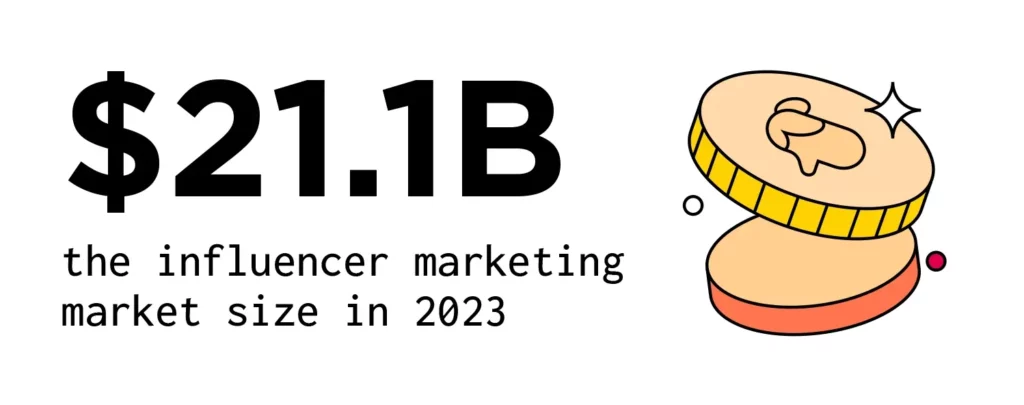Driving sales with influencer marketing is easy once you have the tools to build winning campaigns. We’ve broken down everything you need to know to run a top-notch influencer marketing campaign for conversions.
We’ll dig into the best platforms and strategies to drive traffic and turn those clicks into sales. Plus, we break down the five steps to creating a campaign strategy that works for you and your goals. And, we reveal the optimal influencer marketing ROI and how you can measure a successful campaign.
Influencer marketing is a hot topic right now for good reason. The vast majority of marketers plan to utilize it this year and take advantage of the industry’s 29 percent projected growth year over year. Best to optimize your campaign strategies now while the market is hot.
Jack Harlow isn’t the only one who can put you in first class. With the help of The Shelf, you and your influencers can drive sales and get you one step closer to marketing luxury.
Let’s dive in!
Which Platforms Deliver the Best Influencer Marketing for Conversions?
When it comes to building the perfect influencer marketing strategy, one of the most important decisions you’ll make is which platforms to use. The most popular influencer platforms include Instagram, TikTok, Pinterest, Facebook, YouTube, Blogs, and Podcasts. Twitch and Clubhouse are also popular with specific audiences.
When influencer marketing for conversions, we suggest turning to Instagram and Blogs first. 79 percent of marketers consider Instagram essential to their campaigns. And it’s no surprise — 87 percent of scrollers take action after seeing product information in an Instagram post. That means more conversions!
Bonus points for working with influencers who are present on Instagram and also have their own blogs. These influencers can drive sales from both platforms, which can be a huge help considering the lifespan of an in-feed Instagram post is two days, compared to the two-year longevity of blog posts.
If you’d like a deep dive into choosing the right channels to maximize your influencer marketing impact, download our ebook. It breaks down the benefits, features, and demographics of each platform so you can make an informed decision on which channels to use for your next campaign.
What Should an Influencer Strategy Include?
There are five key steps to creating a successful influencer marketing campaign strategy that will lead to conversions and drive sales. Let’s break them down.
STEP 1: Define your goals.
Because you’re here reading our influencer marketing for conversions post, I’m going to assume your goal is just that: conversions! So congrats, you’re already done with step one. Go ahead and give yourself a pat on the back.
STEP 2: Choose a campaign type.
Once you’ve identified your goals, it’s time to zone in on your audience and the type of influencer campaign that will be most likely to get them to convert. Because you’re here for help on conversions, I’m willing to bet you’ll want to run a traffic/clicks/sales campaign on Instagram or a similar platform.
STEP 3: Find the right influencers.
Macro influencers with well-trafficked Instagram pages and blogs are best for conversion campaigns. (Quick reminder: Macro influencers fall in the 300k to 1M follower range.)
But finding the right influencers doesn’t just mean finding someone with the right size audience. You also need to consider who will be the best fit to fulfill your influencer brief. You’ll get the best content when you play to your creator’s strengths, so make sure you find someone who can create work that aligns with your campaign vision.
STEP 4: Promote and optimize your content.
When striking up a deal with your dream influencer, it’s important to get usage rights for the content they create so you can optimize their creative genius for your campaign. This means scaling content by resharing to brand channels, reposting on different platforms, and even repurposing content at different stages of the campaign.
Make sure you get the most out of your influencer-generated content by optimizing each post and promoting posts using dark posts, boosting, or allowlisting.
STEP 5: Track your results.
If your goal is conversions, of course, you’re going to want to track just how well you’re driving sales with influencer marketing. Use these seven metrics to get an accurate picture of your influencer impact on sales.
How Do You Structure an Influencer Marketing Campaign?
The structure for each influencer marketing campaign differs based on your goals. For example, a brand awareness campaign is going to look different from your campaign for conversions.
Structure your campaign for what you want to achieve. Influencer marketing for conversions generally means structuring around optimizing and retargeting posts. You may not convert visitors the first time, so make sure they’re encountering your products at multiple touchpoints.
We recommend focusing on strategic, aspirational product placement. That means skipping the boring ad-like product placements. Keep your imagery fresh and enticing so it’s more likely to go viral. And don’t forget about the power of SEO to help beef up those influencer click-through rates.
(Word to the wise: Make sure to keep your SEO suuuuper natural, especially on social platforms like Instagram. You can get away with a little clunkier SEO phrases in blog posts, but it’s important to make sure Instagram captions sound like they’re coming from a real person and not an SEO bot.)
What Is the ROI of Influencer Marketing?
Because you’re interested in influencer marketing for conversions, it makes sense to measure your ROI in revenue. The average influencer marketing ROI is about $5.20 for every $1 spent. Not too shabby.
Most marketing teams evaluate the value of their influencer marketing based on conversions and sales. But you can also measure ROI based on impressions and engagement, depending on the goals of your campaign.
Do Influencers Yield Conversions?
To put it simply, HECK YES! Influencer marketing is a $21.1B industry for a reason. According to The State of Influencer Marketing 2023: Benchmark Report, a whopping 82 percent of brand marketers are setting aside dedicated influencer marketing budgets this year, and 67 percent are planning to increase their influencing marketing spending from last year. You don’t see those kinds of numbers unless you know your influencers can drive sales.

One of the most valuable tools in the influencer toolbelt is their audience’s trust. Consumers are more likely to try a product recommended by someone they consider a knowledgeable peer or talented expert than a product recommended by the brand that sells it. That’s why influencer marketing is so great for conversions. Consumers want to be influenced and they want to be able to relate to the creators sharing the content.
What Is a Good Conversion Rate for Influencer Marketing?
The general consensus is that a good influencer marketing conversion rate is 3 percent. Of course, this is a blanket statement applying to campaigns of all lengths and brands of all different industries and sizes.
While it’s great to strive for 3 percent, the best way to determine if your influencer marketing for conversions is successful is to compare your traffic, conversions, sales, and all other KPIs to past campaigns you’ve run. That’s why it’s so important to track your results, so you can use them to inform your next, even better campaign.
What Is a Good ROI for Influencer Marketing?
It’s important to remember that although there is great potential to get a killer return on your investment, upwards of 18 percent of influencer marketing campaigns fail to generate any profit at all. If this is your first rodeo for driving sales with influencer marketing, a good ROI will be any return on your initial investment. The closer you creep to that $5.78 for every $1 spent, the better off you’ll be.
Remember, each campaign is a learning experience. Track your progress and don’t be afraid to experiment. Find what works for your brand and your audience, and lean into your most successful posts. Even if your first conversion campaign doesn’t yield incredible sales, it may garner follower growth, site traffic, and help you build your email list. These are all testaments to the success of your campaign, and they will help you get more sales on your next one!
Running Campaigns for Conversions in Conclusion
Driving sales with influencer marketing can be a breeze once you have the right strategies, influencers, and performance metrics established. I hope this post answers all of your burning questions on how to effectively run an influencer marketing for conversions campaign. If you’re itching for more info, there’s a lot more where that came from.
Subscribe to The Shelf newsletter Tactical Influence to stay up to date on all the hottest influencer marketing trends. Or schedule a strategy call with one of our influencer marketing experts. We’ve got the goods to help you drive sales and crush your quarterly goals. Happy marketing!

About This Author
Ariana Newhouse | B2B Writer
I am a freelance writer and comedian based in Los Angeles. While making people laugh is my jam, it’s not always the company brand. So, I strive to make people feel something. My writing philosophy is collaborative, empathetic, and humanistic. At the end of the day, no matter the message, there are real people on both ends of the process.







